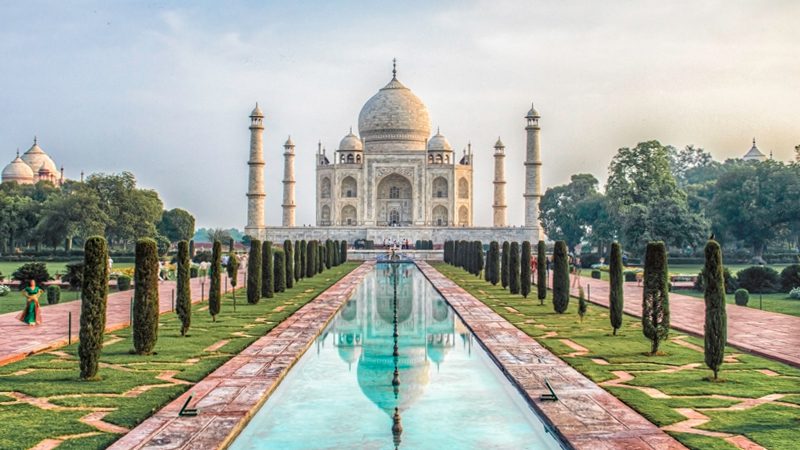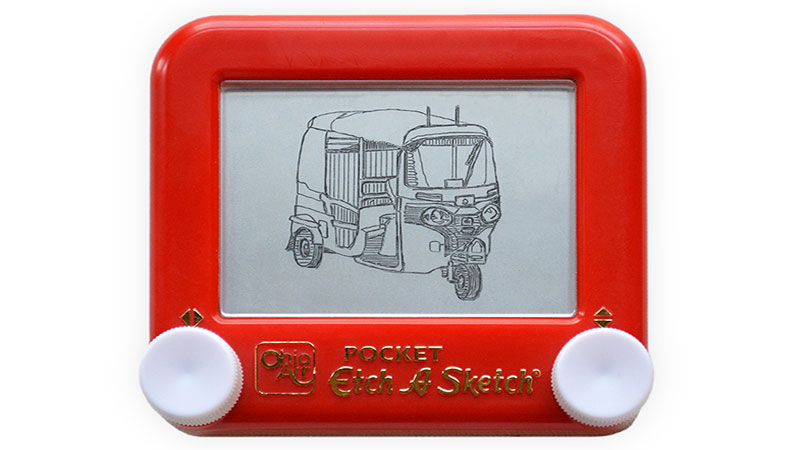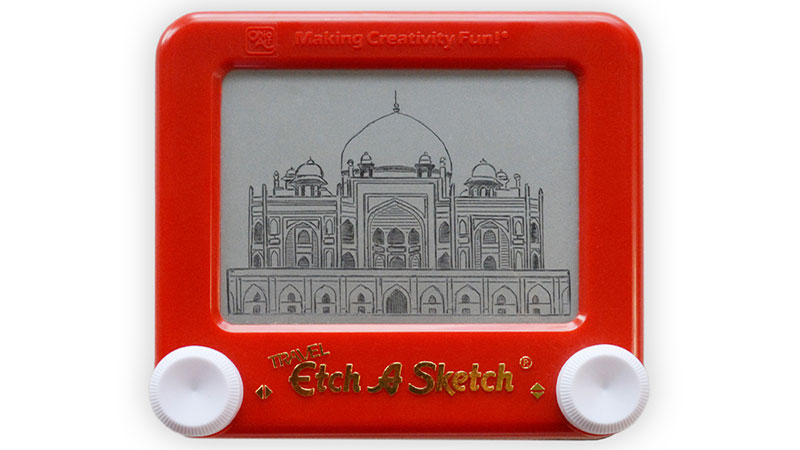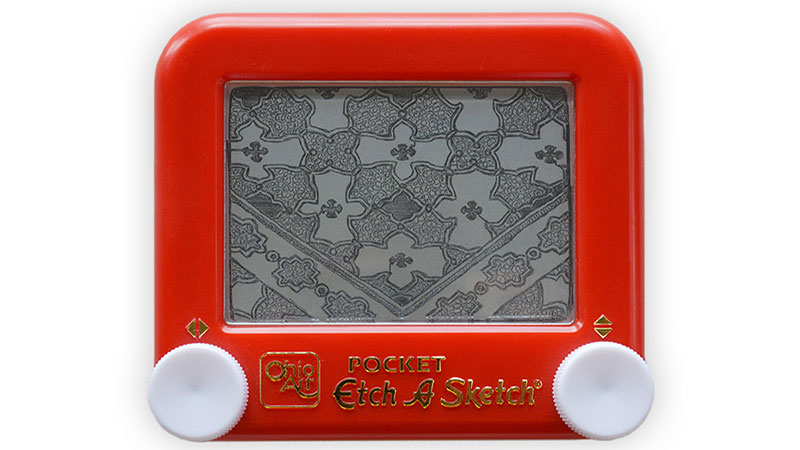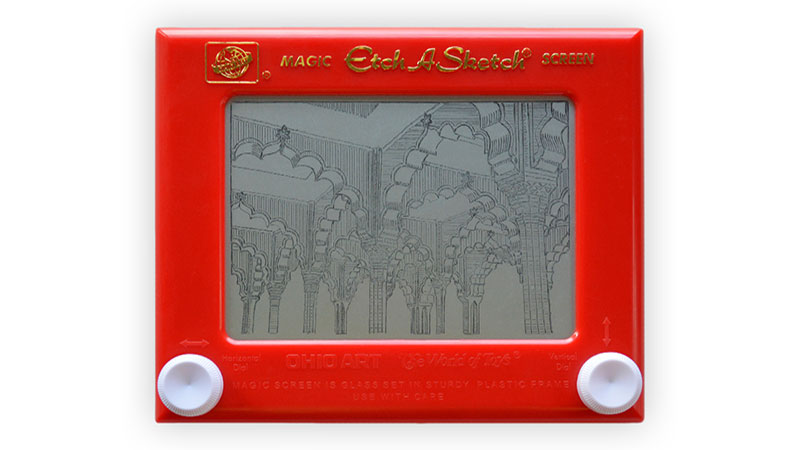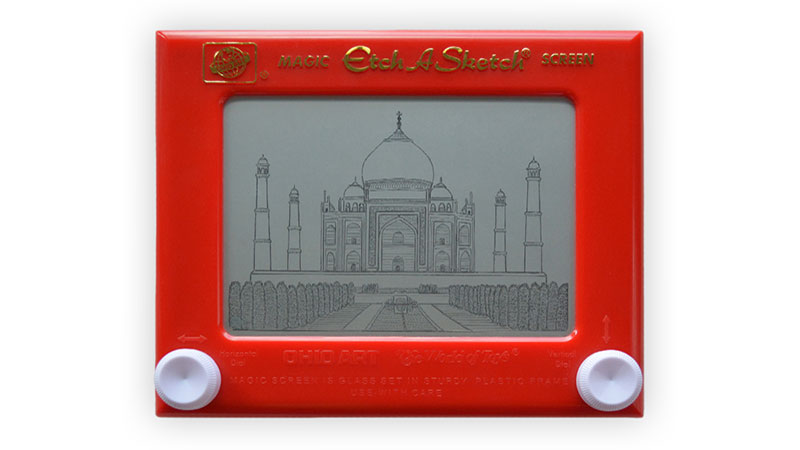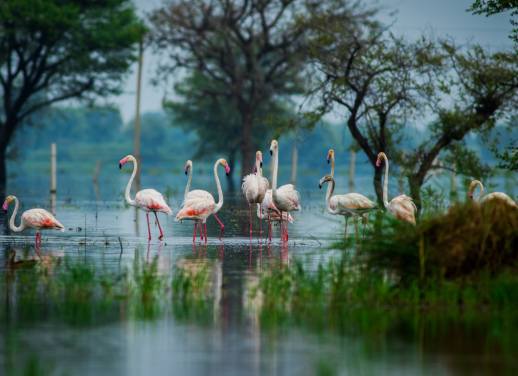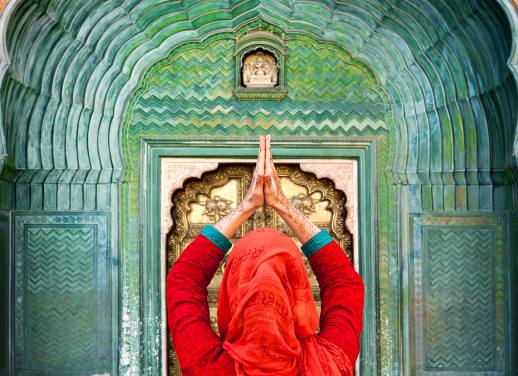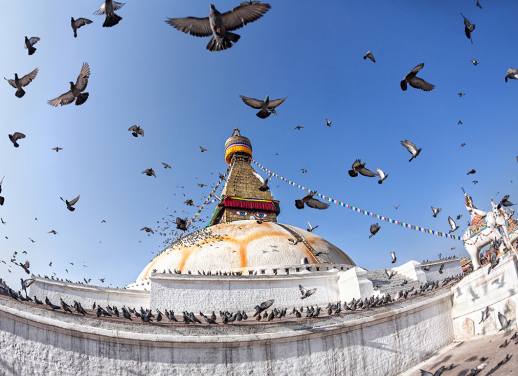Artist Jane Labowitch likes to doodle. In fact she’s made it her full-time profession. And the instrument she’s chosen to do it? None other than the humble Etch A Sketch. That childhood toy that had created innumerable dodgy-looking houses and questionable stick figures since its invention in France way back in 1960.
But Jane goes one step further than your regular ‘etcher’. With a painstaking approach to detail, she can create exquisite works of art using, essentially, two white plastic dials. Up, down, side to side. That’s all it takes to copy artworks as complicated as Seurat’s A Sunday on the Grande Jatte. We loved Jane’s work and sent her on a trip to India with a mission to capture some of the chaos and local colour and bring to to life on the humble Etch A Sketch. We reckon she nailed the brief.
Here are Jane’s Indian masterpieces, complete with a little insight into their creation. Or scroll down for an exclusive etch-a-interview.
Tuk tuks
“I photographed the tuktuk in the middle of a busy street corner in Delhi. I was attracted to this corner because there was so much happening, and it reflected my experience in the city. Everything was in constant motion with the hustle and bustle, and to ride through it all on a tuktuk was quite exhilarating! Creating machinery on an Etch A Sketch can be difficult, because there’s very little room for error. Everything has to be precise, so I made sure to slowly map out where everything on the vehicle lived. I used simple shading mainly consisting of parallel lines so as not to detract from the detailed line work that makes up all the smaller, more intricate elements within the rickshaw.”
Hamayun’s Tomb
“My jaw hit the floor upon first gazing at Hamayun’s Tomb. Made of sandstone and marble, it is reminiscent of the Taj Mahal and the moment I saw it I knew I was going to immortalise it on an Etch A Sketch! The toughest part of this rendition was keeping everything as symmetrical as I could. I used a little artistic license to remove obstructing foliage so that the Etch A Sketch drawing solely focused on the structure.”
Amber Palace – the Hall of Mirrors
“The Amber Palace in Jaipur is gorgeous and insanely intricate! There is a section called the Hall of Mirrors because there are thousands of mirrors embedded into the designs on the wall. I can only imagine how beautiful it must look under candlelight at night. I focused on a small portion of the hall because otherwise it would have been impossible to etch all of the intricate details of the embedded designs on the walls. But even zoomed in, the amount of detail is staggering. Though it took me some time to replicate the pattern on an Etch A Sketch, I’m sure it took the artisans countless hours to create such beautiful designs.”
The Red Fort
“The Red Fort is gigantic! There was so much to take in. My eye was drawn to this beautiful arcade, saturated with grand detail. It continues to blow my mind that pretty much everything I’ve seen in India was built hundreds of years before the US was founded. This Etch A Sketch rendition was one of the most time-consuming for me to create; I’d estimate that it took at least 10 hours in total. There is little room for error when it comes to architectural renditions. I had to take extra care and work slowly to save myself from making a mistake big enough to warrant starting all over again.’
The Taj Mahal
“Our group woke up at 3:30 am so we could see the Taj Mahal at sunrise, and it was definitely worth the early wake-up call. We were the first people in line and, for an ever-so-brief moment, we had a completely unobstructed view of the magnificent structure. Our tour guide shared the story of the Taj Mahal with our group and half of us were crying by the end of it (including me). It is truly the most magnificent monument of love, and I am so thankful that I got to travel across the world to see it.
I was so so excited about creating the Taj Mahal on a full size Etch A Sketch. A couple years ago I created a simpler rendition on a pocket (small) Etch A Sketch, and I’ve been itching to see the real thing ever since. This rendition took over 10 hours to create. As with the Hamayun’s Tomb rendition, I had to take extra care to keep all of the architectural elements symmetrical. The shading in the bushes took a great deal of care as I made very minute loops to give them their texture. The water in the fountain is comprised of minute waves. I decided to keep the shading relatively simplistic on the Taj Mahal itself because I didn’t want to distract from the beauty of the structure. It’s my favourite rendition I created from my trip in India and I’m so proud of how it turned out.”
So Jane, how did you get into Etch A Sketch art?
I started playing with an Etch A Sketch when I was around 4 years old. Growing up, it was one of those toys we had around the house and I would play with it often at my grandma’s to pass the time. I played with the toy so much that I inadvertently taught myself how to move the stylus where I wanted it to go, without having to think about which way to turn the knobs. From there, my Etch A Sketch skills grew with my drawing abilities. If I could draw it, I could etch it! In high school, I was getting a really great response for my Etch A Sketch art so I decided to spend more time on detailed renditions. I went to art school after graduating from high school, and was consistently creating Etch A Sketch art outside of the classroom. It’s something I’ve always done, and I would have never guessed as a kid that I’d be making a living from it today!
What’s the process?
There’s a lot that I do to prepare for an Etch A Sketch drawing before I even start turning knobs. The first thing I do is choose my subject (usually from a photo reference or drawing) and choose which size Etch A Sketch I am going to use. I tend to choose a classic (large) Etch A Sketch for my most detailed work, and the pocket (small) size for quicker, simpler renditions. After determining what I’m going to draw and what size Etch A Sketch I am going to use, I test a few Etch A Sketches in that size to find the one that functions how I want it to. Every Etch A Sketch is a little bit different in how it’s manufactured – for example, some styluses inside the toy draw thicker lines on the screen than others. For simple work, I might prefer a heavy line. For my more intricate work, I lean toward a thin line so that I can capture more detail. After choosing the exact Etch A Sketch I am going to use, I resize my reference photo to be a 1:1 scale to the size of the Etch A Sketch screen, and print it out. I also keep my reference photo open on my computer so I can freely zoom in and understand certain details that my printed photo might not show.
Now that I have all materials at hand, I start etching! I don’t consistently start in the same place, but I prefer to start with the hardest stuff first, because if I don’t like how it turns out, I can start over early. Though I rarely restart, it’s nice to get the difficult parts out of the way first! From there I work on mapping everything out slowly, constantly using my scale reference as a guide to ensure that I am paying attention to proportions. After I finish all of the important line work, I set about the equally time-consuming but significantly easier part of the drawing – shading and details. At this point I am able to relax a little because the line art is taken care of which is the most difficult part of the drawing. I employ various shading techniques, such as parallel lines and minute little squiggles, to register different tones of grey. I sometimes have to go over the same area over a dozen times to get the darkest tones in my work. As I work on the shading, I clean up the initial line work by going over the lines and giving them different weights. I have to be careful, because this part requires me to perfectly trace over lines I’ve already created.
Once I finish the art, I photograph it using natural light. If it’s a work I am particularly proud of, I will preserve it so that it cannot be erased. This is a lengthy and messy process all in itself! I drill a hole in the back of the toy, shake all the powder out, clean the toy thoroughly and go over any lines that might have faded during the preservation process. I then seal the hole and glue down the knobs so they cannot be used to create new lines.
What are your favourite things to draw?
I have always loved drawing people, because every person is unique and it’s a really fun challenge to capture someone’s likeness using only one line. I also love how, in contrast to architecture, people are made up of organic lines that are free-flowing and lack the precision necessary to draw a building. It’s especially fun to draw someone’s portrait from life, because it’s a more difficult challenge than working from a photo.
I really enjoy drawing pop-culture related art on Etch A Sketch as well! It’s my way of paying homage to the things I admire and enjoy, and I’ve gotten great reception from others who are also fans of the things I choose to etch.
Are you planning to combine travel and Etch A Sketch in the future?
Definitely! This trip to India was so much fun and served as amazing artistic inspiration for me. I’d love to continue exploring new destinations and cultures through the screen of an Etch A Sketch. Right now I am working on a series of art at the Art Institute of Chicago, and would love to visit other art museums throughout the world to etch masterworks from life. But I’ve also thought a lot about the idea of etching “en plein air”, or etching landscapes out in the open.
Check out more of Jane’s work at her website, princessetchasketch.com. Or if you want to see India in the flesh, not just the sketch, check out our Intrepid small group adventures.
Feature image c/o Claudio Accheri, Flickr

